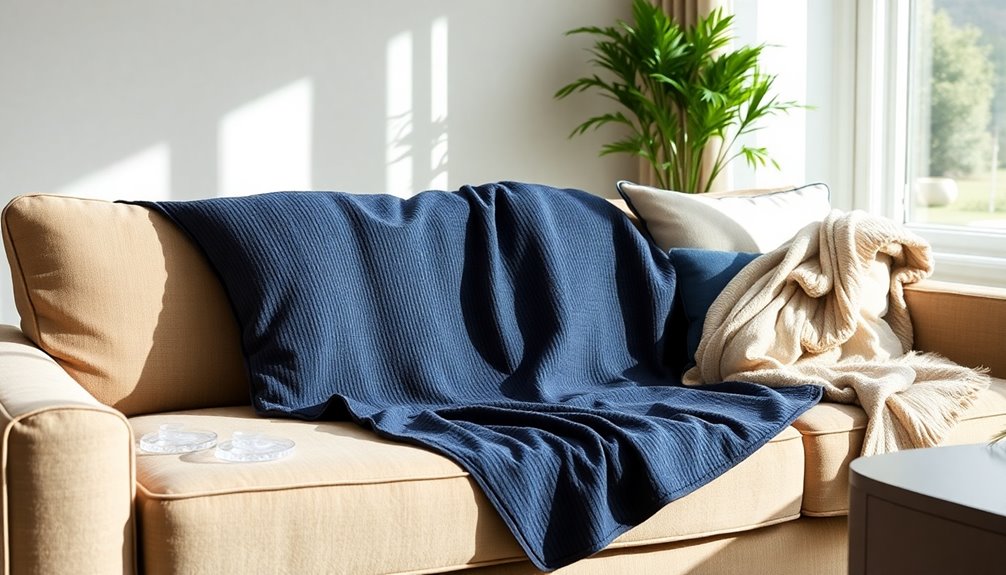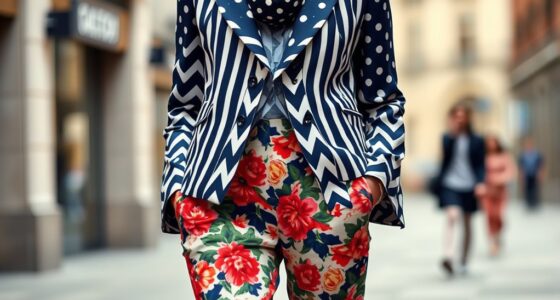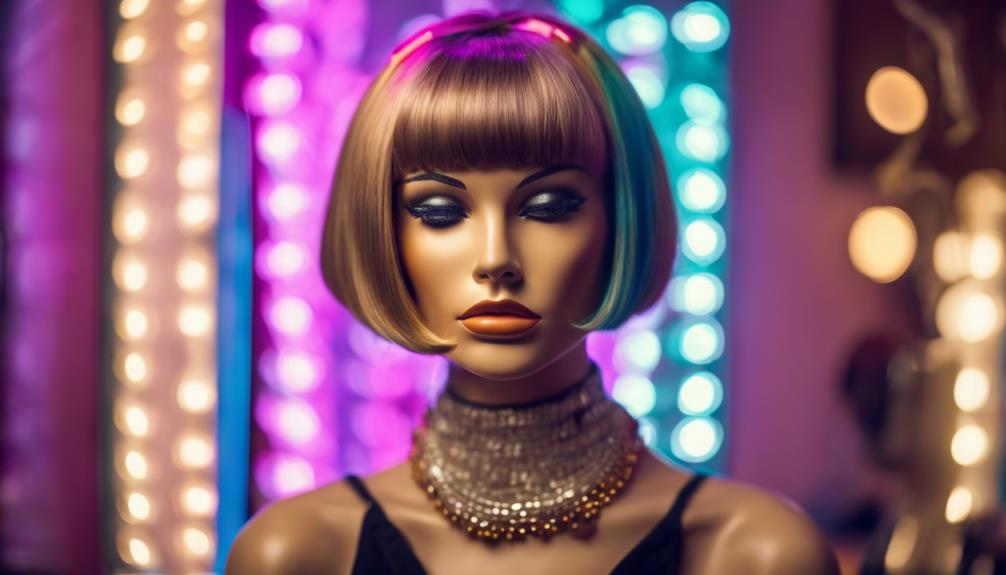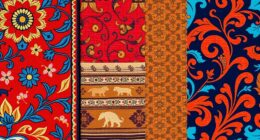European dresses reflect a rich history and modern sophistication that speaks to your sense of style. Think elegant silhouettes, impeccable tailoring, and high-quality fabrics like luxurious silks and velvets. You'll find timeless staples such as the little black dress, A-line, and wrap dresses that flatter any figure. Today, many designers focus on sustainability, using eco-friendly materials to create chic yet responsible fashion. Whether you're heading to a formal event or a casual outing, you can achieve that continental chic effortlessly. If you're intrigued by how to incorporate these styles into your wardrobe, there's plenty more to explore.
Key Takeaways
- European dresses feature elegant silhouettes and impeccable tailoring, enhancing the feminine form with defined waistlines and flowing skirts.
- Timeless staples like the little black dress and wrap dresses offer versatility, ensuring chic choices for various occasions.
- Luxurious fabrics such as silks and velvets elevate evening dresses, promoting a sophisticated and polished appearance.
- Sustainable fashion innovations, including organic materials and upcycling, are increasingly embraced by European designers for eco-friendly elegance.
- Influential fashion houses like Chanel and Prada lead the way in defining continental chic while advocating for sustainable practices and timeless style.
Origin and historical background of the fashion trend/style
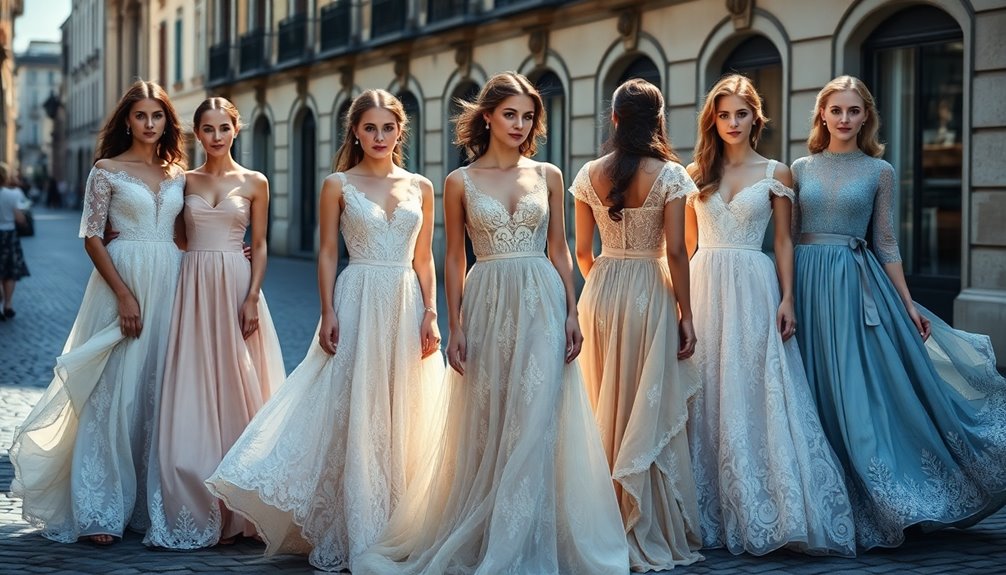
European dresses have undergone a remarkable transformation over the decades, influenced by key cultural icons and movements.
From the opulence of the Renaissance to the revolutionary designs of the 20th century, each era reflects a unique blend of creativity and societal change.
As you explore this evolution, you'll see how these styles continue to shape and inspire modern fashion.
Fashion's Transformation Through Decades
Fashion has undergone a remarkable transformation over the decades, reflecting shifts in culture, society, and technology. Since the 18th century, European fashion evolved dramatically, moving from extravagant styles to more tailored garments. This shift marked a transition toward structured silhouettes that mirrored societal changes.
In the 1920s, the flapper dress emerged, symbolizing women's liberation and a move towards relaxed, functional clothing after World War I. Fast forward to the 1960s, and you'll notice the rise of mod fashion, characterized by bold patterns, mini skirts, and vibrant colors. This era challenged traditional norms and became emblematic of youth culture and rebellion.
The 1980s brought power dressing to the forefront, with shoulder pads and striking colors reflecting women's increasing presence in the corporate world. As we entered the late 20th century and early 21st century, sustainability became a priority. Designers began focusing on eco-friendly materials and ethical practices, responding to growing environmental concerns. This movement aligns with the increasing demand for eco-conscious brands that prioritize ethical production and transparency in supply chains.
The trench coat, a staple throughout these decades, has evolved in style and function, adapting to the changing landscape of fashion while remaining a timeless classic in your wardrobe.
Cultural Icons and Movements
The rich tapestry of cultural icons and movements has profoundly shaped the landscape of fashion throughout history. As you explore European fashion, you can see how the Renaissance sparked a love for art and individualism, leading to luxurious fabrics and elaborate designs.
Fast forward to the 1920s, and the flapper style emerges, symbolizing women's liberation with shorter hemlines and relaxed silhouettes, breaking away from traditional constraints.
Then, in 1947, Christian Dior introduced the 'New Look,' redefining femininity with its hourglass silhouette and opulent materials. This movement influenced women's fashion across Europe, emphasizing elegance and sophistication.
The 1960s brought the Mod movement in Britain, where bold colors and patterns encouraged a playful approach to style, appealing to the youth of the era.
Finally, the 1980s ushered in power dressing, with designers like Yves Saint Laurent and Giorgio Armani crafting tailored suits for women. This trend symbolized empowerment and success in the workplace, allowing women to express their ambitions through fashion.
Each of these movements has left an indelible mark, showcasing how cultural shifts can drive the evolution of style in Europe.
Key Characteristics

When you explore European dresses, you'll notice their elegant silhouettes and impeccable tailoring that seamlessly blend tradition with modernity.
You'll also appreciate the luxurious silks and rich velvets that elevate their appeal, making them perfect for any occasion.
Timeless classic dresses stand out, ensuring you can wear them for years while always looking stylish. Additionally, many designs incorporate natural materials that enhance their overall quality and aesthetic.
Elegant Silhouettes and Tailoring
European dresses are celebrated for their elegant silhouettes and impeccable tailoring, which work together to create a sophisticated and flattering look. You'll often find defined waistlines paired with flowing skirts that enhance the feminine form, making you feel both graceful and confident.
The attention to detail in tailoring is crucial; precisely cut garments ensure a polished appearance that emphasizes your unique silhouette and personal style. High-quality fabrics and meticulous craftsmanship are priorities for many European designers, resulting in dresses that not only fit beautifully but also stand the test of time.
You'll appreciate the use of structure in designs, such as peplum details and structured shoulders, which add a refined touch to various dress styles. These elements contribute to the overall elegance that European fashion embodies.
Additionally, timeless features like asymmetry and minimalist designs allow for versatility, making these dresses suitable for a range of occasions. Whether you're dressing for a formal event or a casual gathering, you'll find that the elegant silhouettes and exceptional tailoring of European dresses elevate your wardrobe to new heights.
Luxurious Silks and Rich Velvets
Luxurious silks and rich velvets stand out as key fabrics in European fashion, embodying elegance and sophistication. You can't help but admire how the smooth texture and natural sheen of silk elevate evening dresses and formal wear, making them a staple across Europe. When you slip into a silk garment, you immediately feel the quality that these materials offer.
On the other hand, rich velvets add depth and opulence to your wardrobe. Often seen in sophisticated designs, they exude a regal quality, especially in fall and winter collections. You'll find that both fabrics are synonymous with high-end fashion, prominently featured in iconic collections from designers like Gucci and Chanel.
As you explore these materials, you'll notice their versatility. They can be tailored into structured gowns or flowing, relaxed silhouettes, adapting to various styles and occasions.
Moreover, the growing consumer preference for sustainable and ethically produced luxury items means that 60% of shoppers are now prioritizing quality and craftsmanship, making silks and velvets more popular than ever. Additionally, investing in high-quality fabrics mirrors the trend of tax-efficient growth in other investment sectors, emphasizing the importance of value in today's market.
Ultimately, these fabrics not only look stunning but also reflect a deeper appreciation for luxury in modern fashion.
Timeless Classic Dresses
Classic dresses embody a timeless elegance that never goes out of style, making them a staple in every wardrobe. You'll find that these dresses often feature elegant silhouettes, like A-line or sheath cuts, which flatter various body types and seamlessly transition from day to night.
The use of luxurious fabrics such as silk, chiffon, and high-quality cotton ensures that your classic dress not only looks stunning but also lasts for years. Many timeless designs showcase neutral tones and subtle patterns, including polka dots or florals, giving you versatile styling options for any occasion.
Thoughtful details like tailored waistlines, structured shoulders, and discreet pockets marry functionality with aesthetic appeal, making these dresses practical yet chic.
When you invest in a well-tailored classic dress, you're making a sustainable choice. You choose quality over fast fashion, ensuring that your dress will remain stylish across multiple seasons and trends. Additionally, the focus on sustainable grooming practices in the beauty industry complements the ethos of classic fashion by promoting eco-friendly choices.
Modern Interpretation

As you explore modern interpretations of European dresses, you'll notice a strong focus on sustainable fabric innovations that are shaping the industry.
Renowned European fashion houses are leading the charge, blending eco-friendly practices with cutting-edge design.
Plus, fashion icons of today are embracing these trends, making them accessible and desirable for a broader audience.
Sustainable Fabric Innovations
Sustainable fabric innovations are transforming the fashion landscape, making it easier for you to choose eco-friendly options without sacrificing style. Fabrics like organic cotton and Tencel are gaining traction, with consumers now preferring sustainable brands 60% of the time. This shift reflects a growing awareness of ethical fashion practices and a desire for environmentally responsible choices.
Innovations in fabric technology, such as recycled polyester and biodegradable textiles, play a crucial role in minimizing the environmental impact of clothing production. With fast fashion generating a staggering 92 million tons of waste annually, these alternatives are essential.
Additionally, the rise of natural dyes and low-impact manufacturing processes shows a commitment to sustainability that resonates with modern consumers.
European designers are leading the charge by prioritizing sustainability, often sourcing materials locally. This not only supports regional economies but also cuts down on the carbon footprint associated with transporting materials.
As the global market for sustainable fashion is projected to reach $8.25 billion by 2023, it's clear that the industry is moving towards a more responsible future. Embracing these innovations allows you to enjoy exquisite European dresses while contributing to a healthier planet.
Renowned European Fashion Houses
In the realm of luxury fashion, renowned European fashion houses like Chanel, Gucci, and Prada aren't just trendsetters; they're redefining the industry's landscape.
Chanel embodies timeless elegance, while Gucci's innovative marketing strategies continue to lead the way in luxury fashion. You can see how these brands shape global trends, influencing what consumers desire.
Balenciaga stands out for its avant-garde designs that comment on societal issues, making it a vital player in contemporary fashion dialogues.
If you're looking for a brand that champions sustainability, Prada is at the forefront, promoting eco-friendly materials and practices in its collections.
Meanwhile, Off-White, helmed by Virgil Abloh, reshapes streetwear culture, blending high fashion with urban influences to attract a younger demographic.
The impact of these fashion houses is significant; they not only dictate trends but also shape consumer behavior.
In fact, research shows that 65% of shoppers are influenced by social media representations of their collections.
With these brands leading the charge, you can expect luxury fashion to continue evolving, creating a dialogue around style, sustainability, and culture that resonates across generations.
Fashion Icons of Today
Today's fashion icons are reshaping the landscape of European style, blending tradition with modernity in ways that captivate global audiences. Bella and Gigi Hadid stand out with their bold styling choices, utilizing their strong social media presence to influence trends worldwide. They redefine European chic, making it accessible and relatable to younger consumers.
Designers like Alessandro Michele of Gucci and Demna Gvasalia of Balenciaga challenge conventional norms, pushing the boundaries of what defines European fashion. Their innovative designs often spark conversation, blending classic elements with contemporary flair.
Meanwhile, celebrities like Emma Watson and Timothée Chalamet champion sustainable fashion, reflecting the growing consumer demand for ethical choices.
Influencers like Chiara Ferragni and Danielle Peazer highlight the beauty of everyday European elegance, curating content that emphasizes personal style. Their influence shows that fashion isn't just about high-end labels; it's about expressing individuality.
Finally, the rise of streetwear, led by figures like Virgil Abloh, merges high fashion with casual wear, appealing to a younger audience eager for comfort and style. Together, these icons and designers create a vibrant tapestry of modern European fashion that resonates with you today. This fusion not only democratizes the fashion landscape but also encourages experimentation, as seen in collaborations that redefine traditional silhouettes. For instance, pairing oversized tees with sleek leather pants from Zara offers a fresh take on everyday attire. Such combinations illustrate how modern fashion transcends boundaries, inviting everyone to express their individuality through versatile pieces.
Styling Tips
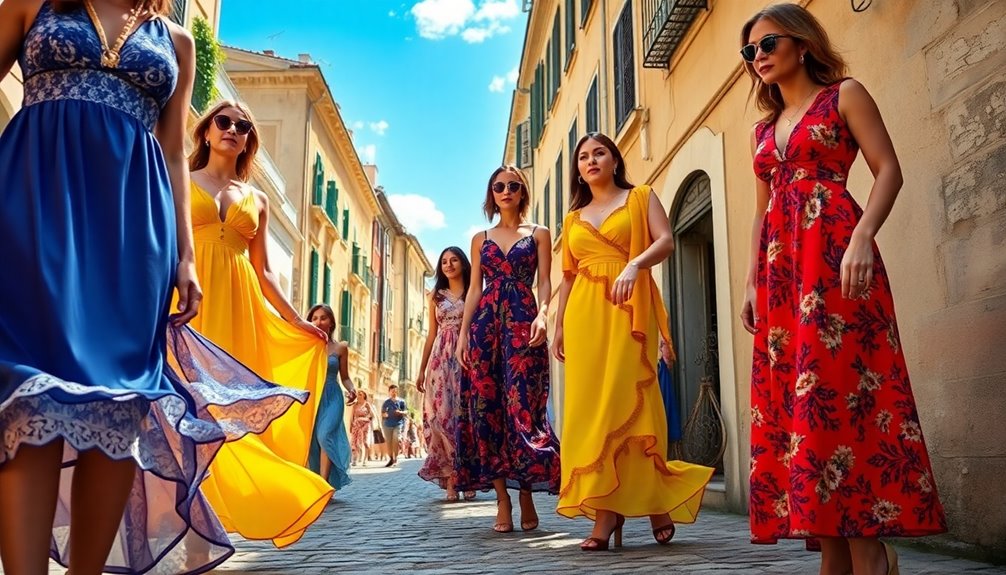
When styling your European dress, focus on key dress types that suit your body shape and occasion.
Use chic layering techniques to add depth and interest, while color coordination can enhance your overall look.
Let's explore how to achieve that effortlessly stylish vibe with these essential tips. Additionally, remember that effective preparation for consultations can help you define your personal style and ensure your choices align with your vision.
Key Dress Types
Throughout the seasons, European fashion showcases a variety of key dress types that can elevate your wardrobe. The little black dress (LBD) remains a timeless staple, effortlessly styled with various accessories to transition from day to night.
Pair it with statement jewelry and strappy heels for an evening out, or opt for a denim jacket and sneakers for a more casual look.
A-line dresses are another versatile option, flattering many body shapes while maintaining a chic vibe. You can wear them with ankle boots for a laid-back feel or dress them up with heeled sandals.
Midi dresses are perfect for any occasion; layer them with blazers or denim jackets to achieve a polished appearance.
Wrap dresses are popular for their universally flattering silhouette; dress them up with heels for a formal event or keep it casual with loafers.
Lastly, floral maxi dresses embody a romantic, bohemian aesthetic. Style them with statement handbags and minimalist jewelry for an effortlessly chic look.
Chic Layering Techniques
Mastering chic layering techniques is key to achieving that effortlessly stylish European look. Start with a fitted base layer, like a turtleneck or classic white button-up, to create a streamlined silhouette. This sets the foundation for adding bulkier pieces without losing shape.
Next, incorporate lightweight cardigans or tailored blazers. These staples transition seamlessly from day to night, lending sophistication to any outfit.
Don't forget the power of accessories! A stylish scarf not only provides warmth but can also elevate a simple dress or top in seconds. You can drape or tie it to add an extra touch of flair.
To keep your look fresh and engaging, experiment with textures and patterns. Mix knits with silky fabrics, or try a striped top underneath a solid blazer to create depth and visual interest.
Incorporating educational toys into your children's playtime can also enhance their creativity and problem-solving skills, much like how layering can enhance your style.
This playful approach ensures your layered outfits stand out while maintaining that chic European essence.
Color Coordination Techniques
Color coordination is essential for creating stylish European outfits that turn heads. Start with a neutral color palette as your foundation; this makes mixing and matching a breeze while allowing pops of color to make bold statements. Think subtle beiges, grays, and whites paired with vibrant hues for that chic flair.
Don't shy away from incorporating stripes and patterns into your look—just ensure they harmonize with your overall color scheme. Monochrome outfits can also be a game changer; they exude effortless chic and create a streamlined silhouette that elongates your figure.
Earthy tones are another great choice, grounding your outfits and lending a natural, sophisticated vibe perfect for transitioning between seasons.
Finally, leverage accessories like scarves and handbags to introduce complementary colors or textures. These little details enhance the cohesiveness of your outfit without overwhelming it. Furthermore, consider the influence of the brewing techniques you enjoy, as they can inspire your color choices and overall aesthetic in fashion.
Shopping Guide
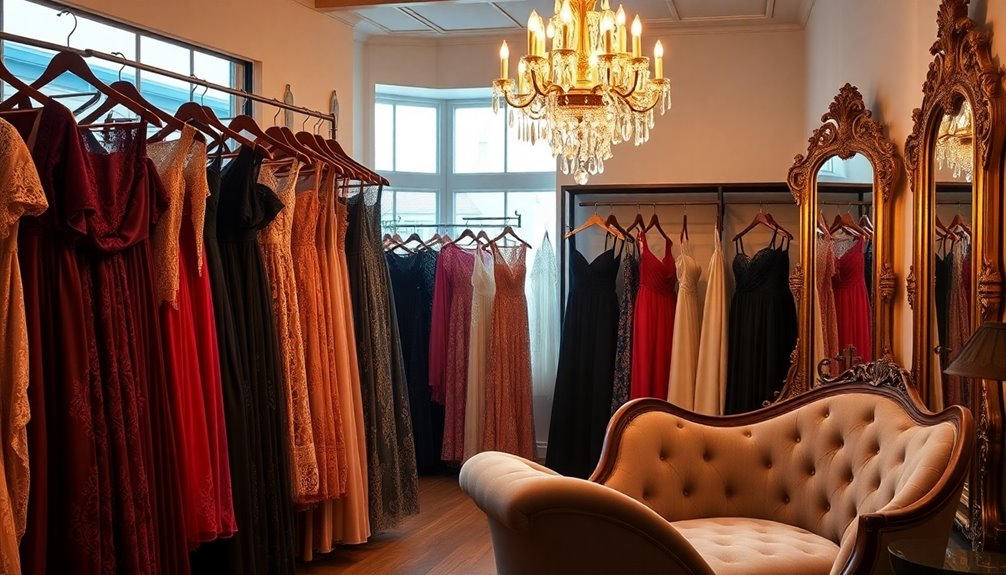
When you're on the hunt for European dresses, focus on timeless silhouettes that can easily transition from day to night, like the beloved little black dress. This staple is a must-have in many European wardrobes, and it's perfect for dressing up with heels or down with sandals.
Next, prioritize brands that emphasize sustainability. With 60% of consumers now valuing ethical practices in fashion, choosing environmentally conscious labels not only feels good but also aligns with current trends.
Don't shy away from local boutiques and vintage shops, either; thrift shopping is gaining popularity and can lead you to unique pieces that truly embody continental chic.
As you shop, pay close attention to fabric quality and fit. European fashion often highlights tailored styles and luxurious materials, steering clear of fast fashion trends.
Lastly, consider incorporating bold patterns and earthy tones into your collection. These vibrant aesthetics reflect the current fashion landscape and can add flair to your wardrobe. Additionally, remember that diversification in your wardrobe can enhance your personal style and make it more versatile.
Upcycling Vintage European Dresses

When you upcycle vintage European dresses, you can repurpose beautiful fabrics into fresh styles that showcase your creativity.
Tailoring these pieces for a perfect fit not only enhances your wardrobe but also honors the craftsmanship of their original designs.
This approach allows you to create unique fashion statements while being mindful of sustainability.
Repurposing Fabrics for New Styles
Upcycling vintage European dresses is a creative way to breathe new life into forgotten fabrics while embracing sustainability. By repurposing these older garments, you not only reduce textile waste—contributing to the fight against the 92 million tons generated by fast fashion each year—but you also promote a more ethical fashion industry.
Designers are increasingly crafting unique pieces that reflect contemporary trends while honoring the craftsmanship of vintage styles. Farmhouse designs often incorporate elements of sustainability and creativity, making them a fitting inspiration for those looking to revitalize their wardrobes.
With the rise in popularity of vintage and thrift shopping, more consumers are seeking sustainable practices. This trend has made upcycling a fashionable choice, as many brands now incorporate upcycled materials into their collections. In fact, around 60% of consumers prioritize sustainable brands, pushing the fashion world toward more responsible practices.
Upcycling isn't just about sustainability; it also allows you to express your creativity and personalize your wardrobe. By transforming vintage dresses into new styles, you can create one-of-a-kind pieces that truly reflect your personality.
Tailoring for a Perfect Fit
Transforming vintage European dresses through tailoring not only elevates their aesthetic appeal but also ensures a perfect fit that enhances your comfort. When you upcycle these unique pieces, you create custom silhouettes that reflect current fashion trends while prioritizing sustainability.
Tailoring allows you to adapt a vintage dress to your body, making it a one-of-a-kind garment that feels just right.
Investing in tailored vintage dresses not only reduces fashion waste but also aligns with the growing number of consumers who prioritize sustainability—about 60% of shoppers today consider this in their wardrobe choices.
By properly tailoring these vintage finds, you increase their longevity and wearability, counteracting the fast fashion trend that generates an astounding 92 million tons of waste annually.
Additionally, the recent resurgence of interest in vintage fashion has sparked a 70% rise in thrift shopping. This trend reflects a desire for individuality and timeless elegance, allowing you to express your unique style while embracing sustainable practices. Moreover, this cultural shift mirrors the growing consciousness about the impact of fast fashion, highlighting the importance of making mindful choices in our wardrobe selections.
Cultural Impact

When you look at European dresses, you can't ignore how film and television shape public perception and trends.
From iconic movie costumes to the latest series, these influences often drive fashion-forward political activism, making style a powerful statement.
Understanding this interplay helps you appreciate the deeper cultural conversations happening through clothing.
Film and Television Influences
How do film and television shape our perceptions of European fashion? They play a crucial role in presenting and popularizing styles that often define trends worldwide.
Take films like "La La Land" and "Amelie," for example. These movies celebrate classic European aesthetics, setting the stage for elegant fashion moments that inspire your wardrobe choices.
Television series, particularly "Emily in Paris," have brought continental chic to the forefront, showcasing stylish characters that embody the essence of French fashion. This exposure sparks interest in similar clothing styles, making you crave that effortless Parisian look.
Fashion designers recognize this influence, often collaborating with productions to create signature looks that tell cultural stories, like Gucci's partnership with "House of Gucci."
Historical dramas such as "The Crown" also play their part, highlighting vintage styles that encourage modern consumers to embrace similar silhouettes and fabrics.
Finally, fashion-focused documentaries, like "The September Issue," educate you on the cultural significance of European style, deepening your appreciation for the craftsmanship behind those stunning dresses.
Ultimately, film and television are powerful catalysts for shaping how you perceive and engage with European fashion.
Fashion-Driven Political Activism
The influence of film and television isn't just about style; it's also about sparking conversations around social and political issues. You may have noticed that fashion-driven political activism is on the rise, with both individuals and brands expressing their values through clothing choices.
In fact, 60% of consumers now prioritize sustainable and ethically-made garments, reflecting a growing commitment to social responsibility in fashion.
High-profile events like Fashion Weeks have become platforms for designers to address pressing issues, often infusing their collections with messages that resonate with global movements.
Social media amplifies this effect, with 65% of shoppers influenced by online trends that champion political and social causes.
Sustainable fashion initiatives are responding to the environmental crisis, highlighting the staggering 92 million tons of waste produced by the fast fashion industry annually.
Influential designers like Stella McCartney are leading the charge, intertwining activism with their brand identities to advocate for animal rights and eco-friendly practices.
This shift not only reshapes how you perceive luxury fashion but also empowers you to make choices that align with your values, proving that style and substance can coexist beautifully.
Frequently Asked Questions
What Are the Best Fabrics for European Dresses?
When choosing the best fabrics for European dresses, you should consider options like silk, linen, and cotton.
Silk gives an elegant drape and luxurious feel, perfect for formal occasions.
Linen's breathable nature makes it ideal for warm weather, while cotton offers comfort and versatility for everyday wear.
Blends like silk-cotton can provide both durability and sheen.
Always think about the dress style and season to ensure you pick the right fabric for your needs.
How Can I Identify Authentic Vintage European Dresses?
To identify authentic vintage European dresses, you should start by examining the fabric and stitching.
Look for high-quality materials like silk or linen, and check for hand-stitched seams, which indicate craftsmanship.
Inspect labels for specific brand names or country of origin, as these can signal authenticity.
Finally, research fashion history to familiarize yourself with styles and trends from different eras, helping you spot genuine pieces among reproductions.
Are There Specific Colors Trending in European Dress Fashion?
Right now, you'll notice a shift toward earthy tones and pastels in European dress fashion.
Colors like terracotta, sage green, and soft lavender are trending, giving outfits a fresh, vibrant feel.
You might also spot bold hues like deep red and royal blue making a comeback, perfect for making a statement.
Keep an eye on fashion runways and street styles; they'll give you the best insights into what's popular this season.
How Do I Care for Vintage European Dresses?
Caring for vintage European dresses requires a gentle touch.
Start by checking the fabric type and cleaning instructions. Hand wash in cold water with a mild detergent, or dry clean if it's delicate. Avoid direct sunlight to prevent fading.
Store them flat or hanging in a cool, dry place, using padded hangers for support.
Regularly inspect for any signs of wear or damage, and address issues promptly to preserve their beauty.
Can I Wear European Dresses for Casual Occasions?
Absolutely, you can wear European dresses for casual occasions!
Just choose styles that feel relaxed and comfortable, like a flowy sundress or a simple midi. Pair it with sneakers or flat sandals for a laid-back vibe.
Don't forget to accessorize with a crossbody bag and minimal jewelry to keep it chic yet casual.
Embrace the versatility of these dresses, and you'll look effortlessly stylish no matter where you're headed!

